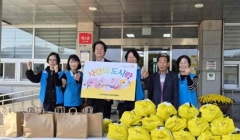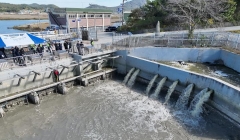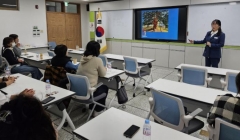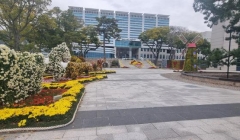 수도권 중심의 송정정책 전면 재검토 및 에너지 생산지역 균형발전 촉구 건의문 / 사진제공=해남군의회 |
정부는 탄소중립 실현과 국가 전력망 효율화를 명분으로 '에너지 고속도로' 사업을 추진하고 있으나, 이는 지방의 전력을 수도권으로 송전하는 에너지 불균형 구조를 더욱 고착화함으로써 에너지 생산지역을 단순한 ‘전력 공급지’로 전락시키고 있다.
전남 서남권은 국내 최고의 해상풍력과 태양광 자원을 보유하고 있으나, 정부의 제10·11차 장기 송·변전 설비계획은 에너지 고속도로 중심의 인프라 확충에만 치중하여 지역의 전력 활용과 지역사회 발전 가능성을 외면하고 있다. 이로 인해 지역 주민들은 송전선로와 변전시설로 인한 환경 훼손과 생활권 침해라는 부담을 떠안으면서도, 정작 생산된 전력의 경제적·사회적 이익은 수도권으로 집중되는 불합리한 상황에 놓여 있다.
이는 헌법 제119조 제2항이 명시한 지역 간 균형발전 원칙과 어긋나며, 지역에서 생산한 에너지를 지역에서 소비·활용하도록 하는 「분산에너지 활성화 특별법」의 입법 취지와도 배치된다. 더욱이 이재명 대통령이 강조해 온 '지산지소(地產地消)' 원칙을 실현하기 위해서도 생산지 중심의 분산형 전력체계로의 전환이 필요하다.
최근 정부가 추진 중인 맹골도 해상풍력 전력망 계획은 이러한 문제를 극명하게 보여준다. 맹골도 해상풍력에서 생산된 전력을 송지·현산 등을 거쳐 성전 변전소로 연결하는 이 계획은 지역 내 전력 활용 기반은 전혀 고려하지 않은 채 수도권 송전 효율만을 우선시하고 있다.
또한 신해남-신장성 송전선로 건설사업 역시 지역의 RE100 산업단지 전력 공급이 아닌 수도권으로의 송전을 목적으로 추진되고 있다. 결과적으로 송전 선로 건설에 따른 혜택은 수도권이 가져가면서 지역 주민은 환경 훼손과 생활권 침해를 떠안고, 지역 발전 기회는 차단되는 불공정한 구조가 고착되고 있다.
더욱 심각한 것은 용인 반도체 클러스터 조성사업이다. 이 사업은 약 10GW의 막대한 전력을 필요로 하는데, 이는 전남 지역 전체의 연간 전력 생산량과 맞먹는 수준이다. 그러나 정부는 전력 공급 대책도 충분히 마련하지 않은 채 수도권 중심의 산업정책을 무리하게 추진함으로써 전국 곳곳에 초고압 송전선로를 건설해야 하는 상황을 초래하고 있다. 이는 지역 주민의 환경권과 생활권을 광범위하게 침해하고, 막대한 송전비용과 전력 손실을 야기하는 극도로 비효율적인 구조다. 결국 에너지 생산지 주민의 일방적 희생을 통해 수도권 산업 발전을 뒷받침하는 불균형 구조가 심화되고 있다.
근본적인 문제는 에너지 고속도로 정책과 'RE100 산업단지' 정책이 본질적으로 상충된다는 점이다. 정부는 한편으로 청정에너지 활용을 위한 RE100 산업단지를 추진하면서도, 다른 한편으로는 지역에서 생산된 청정에너지를 수도권으로 송전하는 정책을 고수하고 있다. 이는 정책의 일관성이 결여될 뿐 아니라, 진정한 탄소중립과 지역균형발전을 가로막는 구조적 모순을 초래하고 있다.
진정한 탄소중립과 균형발전을 위해서는 에너지를 생산한 지역에서 소비하고, 그로 인한 경제적 이익이 지역사회로 환원되는 선순환 구조로의 전환이 필수적이다. 그러나 현행 정책은 농어촌 지역을 단순한 수도권의 전력공급처로 전락시키는 낡은 중앙집권적 사고방식에서 벗어나지 못하고 있다.
이에 해남군의회는 정부에 다음과 같이 강력히 촉구한다.
하나, 맹골 해상풍력의 전력망 계획 등 수도권 중심의 에너지 송전 정책을 전면 재검토하고 지역 내 생산·소비형 분산 전력체계로 전환하라.
하나, 용인 반도체 클러스터 등 대규모 전력 수요 산업의 수도권 집중 정책을 파기하고, 전남 등 청정에너지 생산지역에 관련 산업을 분산 배치하여 에너지 자립형 지역균형발전을 실현하라.
2025. 10. 29.
해남군의회 의원 일동
[Press Release]
[Haenam = Haenam News] haenamnews@naver.com
Resolution Urging a Comprehensive Review of Seoul-Centric Power Transmission Policy and Promotion of Balanced Development in Energy-Producing Regions
The government is pursuing the “Energy Highway” project under the justification of achieving carbon neutrality and improving national power grid efficiency. However, this project further entrenches an energy imbalance that transmits electricity from local regions to the Seoul metropolitan area, reducing energy-producing regions to mere “power supply zones.”
The southwestern region of Jeollanam-do boasts the country’s top offshore wind and solar energy resources. Yet, the government’s 10th and 11th Long-Term Transmission and Substation Plans focus solely on expanding infrastructure centered on the Energy Highway, ignoring the potential for local electricity utilization and regional development. As a result, local residents bear the burden of environmental damage and disruption to their living areas from transmission lines and substations, while the economic and social benefits of the electricity produced are concentrated in the metropolitan area—an inherently unfair situation.
This violates the constitutional principle of balanced regional development stipulated in Article 119, Paragraph 2, and runs counter to the legislative intent of the “Special Act on the Activation of Distributed Energy”, which promotes local consumption and utilization of locally produced energy. Moreover, realizing the principle of “local production for local consumption (jisan-jiso)” emphasized by President Lee Jae-myung requires a transition to a distributed power system centered on production regions.
The government’s ongoing plan for the Maenggol-do offshore wind power grid starkly illustrates this problem. Under this plan, electricity generated from Maenggol-do is transmitted through Songji and Hyeonsan to Seongjeon Substation, prioritizing transmission efficiency to the metropolitan area without any consideration for local electricity utilization.
Similarly, the Shin-Haenam–Shin-Jangseong transmission line project is being pursued not to supply electricity to local RE100 industrial complexes, but to transmit power to the metropolitan area. Consequently, the benefits of constructing these transmission lines accrue to the metropolitan area, while local residents shoulder environmental damage and disruption to their living areas, and opportunities for regional development are blocked, creating an entrenched unfair structure.
Even more serious is the case of the Yongin semiconductor cluster project, which requires approximately 10 GW of electricity—roughly equivalent to the annual power output of the entire Jeonnam region. Yet the government is pursuing this Seoul-centric industrial policy without sufficient electricity supply measures, resulting in the construction of ultra-high-voltage transmission lines nationwide. This not only extensively infringes on residents’ environmental and living rights but also causes enormous transmission costs and power losses, perpetuating a highly inefficient structure. Ultimately, this deepens an imbalanced system in which energy-producing communities bear unilateral sacrifices to support industrial development in the metropolitan area.
The fundamental problem is that the Energy Highway policy and the RE100 industrial complex policy are inherently contradictory. On one hand, the government promotes RE100 industrial complexes to utilize clean energy, while on the other hand, it persists in transmitting locally produced clean energy to the metropolitan area. This lack of policy consistency not only hinders true carbon neutrality but also obstructs balanced regional development.
Achieving genuine carbon neutrality and balanced development requires a transition to a virtuous cycle in which energy is consumed where it is produced, and the resulting economic benefits are reinvested in local communities. However, current policies remain entrenched in an outdated, centralized mindset that reduces rural areas to mere power suppliers for the metropolitan area.
Accordingly, the Haenam County Council strongly urges the government to take the following actions:
Conduct a comprehensive review of Seoul-centric power transmission policies, including the Maenggol offshore wind power grid plan, and transition to a distributed power system that enables local production and consumption.
Abandon the metropolitan-focused policy of concentrating large-scale electricity-demanding industries, such as the Yongin semiconductor cluster, and instead disperse relevant industries to clean energy-producing regions such as Jeonnam to realize energy self-sufficient regional balanced development.
October 29, 2025
All Members of Haenam County Council
해남뉴스 박갑석 기자 haenamnews@naver.com
 2025.11.14 (금) 11:24
2025.11.14 (금) 11:24


































